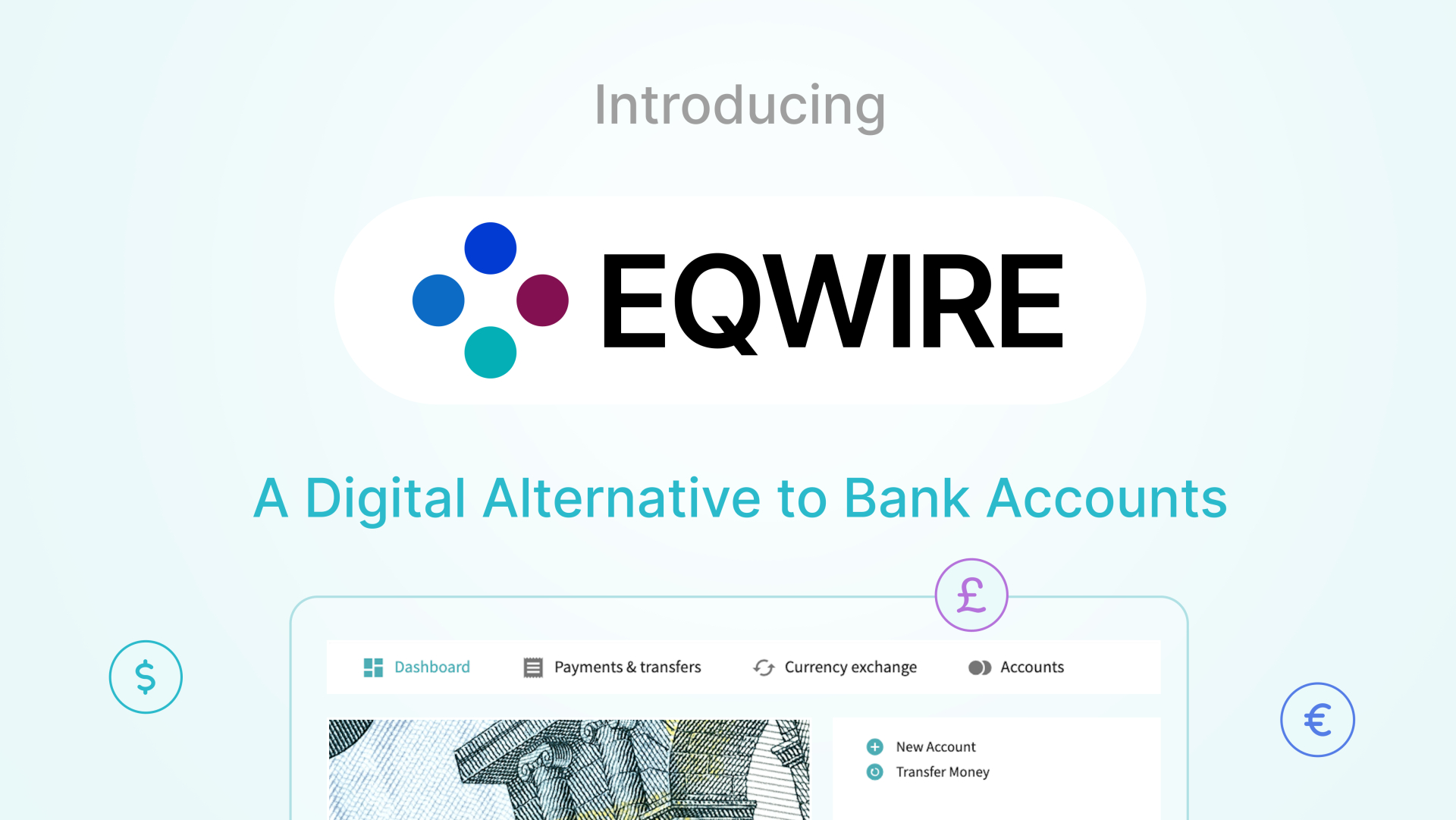Transak expands stablecoin services US licenses, gaining approval in five states to enhance regulated fiat-to-crypto payment operations. The post Transak expands stablecoin services with 5 new US state licenses appeared first on Crypto Briefing.
Tag: infrastructure
The post EQWIRE Launches Digital Alternative to Bank Accounts for Global Customers appeared com. London, The United Kingdom, November 11th, 2025, FinanceWire Global cross-border payments are projected to exceed €268 trillion by 2030, driven by the globalization of trade and remote work. Yet, international transactions still face delays or hidden fees due to outdated banking systems. As demand for faster, more transparent money movement accelerates, EQWIRE, UK Electronic Money Institution, licensed and regulated by the Financial Conduct Authority (FCA, FRN 901100), enters the market with a regulated, technology-first solution designed to close this gap. The company announces the launch of its digital platform for money management and international payments. It offers a new standard in cross-border financial transactions, combining speed, transparency, and regulatory compliance in one online solution. Built with the vision to become the global standard in digital payments, EQWIRE combines multi-currency e-money accounts, instant onboarding, and institutional-grade compliance within a single online platform. The solution is aimed at freelancers, small and medium-sized businesses, as well as international companies that require a reliable and flexible infrastructure for daily payments. “EQWIRE was created as a response to the growing business need for transparent, flexible and secure solutions for international payments. We strive to simplify the movement of money around the world while maintaining the highest standards of compliance and trust,” says Arthur Azizov, Founder of EQWIRE. The platform is built on its own technological architecture, providing instant connection to payment networks, API integration for business, and full compliance with EMI regulation requirements. All client funds are stored in segregated accounts and are protected in accordance with Electronic Money Regulations 2011. EQWIRE is already available to customers from the UK and.
HYBE’s superfan platform Weverse is making significant inroads into China through strategic partnerships with two of the market’s digital giants: Tencent Music Entertainment and Alibaba. The moves mark a pivotal moment in HYBE’s international expansion strategy, as it confirms that Weverse reached a record high of 11. 6 million monthly active users (MAUs) globally in Q3 . Continued Source.
Quick Facts: ➡️ Tangem is launching Tangem Pay a virtual Visa card that simplifies stablecoin payments around the world. ➡️ Tangem Pay will be available for US users by the end of November, while Latin American, Asian, and European users will be able to access the platform in the next phases of the rollout. [.].
DEEP DIVE From stolen military credentials to AI-generated personas seamlessly breaching critical infrastructure, digital identity fraud is rapidly escalating into a frontline national security threat. This sophisticated form of deception allows adversaries to bypass traditional defenses, making it an increasingly potent weapon. The 2025 Identity Breach Report, published by AI-driven identity risk firm Constella Intelligence, reveals a staggering increase in the circulation of stolen credentials and synthetic identities. The findings warn that this invisible epidemic, meaning it’s harder to detect than traditional malware, or it blends in with legitimate activity, is no longer just a commercial concern-it now poses a serious threat to U. S. national security.“Identity verification is the foundation of virtually all security systems, digital and physical, and AI is making it easier than ever to undermine this process,” Mike Sexton, a Senior Policy Advisor for AI & Digital Technology at national think tank Third Way, tells The Cipher Brief. “AI makes it easier for attackers to simulate real voices or hack and steal private credentials at unprecedented scale. This is poised to exacerbate the cyberthreats the United States faces broadly, especially civilians, underscoring the danger of Donald Trump’s sweeping job cuts at the Cybersecurity and Infrastructure Security Agency.”The Trump administration’s proposed Fiscal Year 2026 budget would eliminate 1, 083 positions at CISA, reducing staffing by nearly 30 percent from roughly 3, 732 roles to around 2, 649. Save your virtual seat now for The Cyber Initiatives Group Winter Summit on December 10 from 12p 3p ET for more conversations on cyber, AI and the future of national security. The Industrialization of Identity TheftThe Constella report, based on analysis of 80 billion breached records from 2016 to 2024, highlights a growing reliance on synthetic identities-fake personas created from both real and fabricated data. Once limited to financial scams, these identities are now being used for far more dangerous purposes, including espionage, infrastructure sabotage, and disinformation campaigns. State-backed actors and criminal groups are increasingly using identity fraud to bypass traditional cybersecurity defenses. In one case, hackers used stolen administrator credentials at an energy sector company to silently monitor internal communications for more than a year, mapping both its digital and physical operations.“In 2024, identity moved further into the crosshairs of cybercriminal operations,” the report states. “From mass-scale infostealer infections to the recycling of decade-old credentials, attackers are industrializing identity compromise with unprecedented efficiency and reach. This year’s data exposes a machine-scale identity threat economy, where automation and near-zero cost tactics turn identities into the enterprise’s most targeted assets.”Dave Chronister, CEO of Parameter Security and a prominent ethical hacker, links the rise in identity-based threats to broader social changes.“Many companies operate with teams that have never met face-to-face. “This has created an environment where identities are increasingly accepted at face value, and that’s exactly what adversaries are exploiting.”When Identities Become WeaponsThis threat isn’t hypothetical. In early July, a breach by the China-linked hacking group Volt Typhoon exposed Army National Guard network diagrams and administrative credentials. U. S. officials confirmed the hackers used stolen credentials and “living off the land” techniques-relying on legitimate admin tools to avoid detection. In the context of cybersecurity, “living off the land” refers to attackers (like the China-linked hacking group Volt Typhoon) don’t bring their own malicious software or tools into a compromised network. Instead, they use the legitimate software, tools, and functionalities that are already present on the victim’s systems and within their network.“It’s far more difficult to detect a fake worker or the misuse of legitimate credentials than to flag malware on a network,” Chronister explained. Unlike traditional identity theft, which hijacks existing identities, synthetic identity fraud creates entirely new ones using a blend of real and fake data-such as Social Security numbers from minors or the deceased. These identities can be used to obtain official documents, government benefits, or even access secure networks while posing as real people.“Insider threats, whether fully synthetic or stolen identities, are among the most dangerous types of attacks an organization can face, because they grant adversaries unfettered access to sensitive information and systems,” Chronister continued. Insider threats involve attacks that come from individuals with legitimate access, such as employees or fake identities posing as trusted users, making them harder to detect and often more damaging. Constella reports these identities are 20 times harder to detect than traditional fraud. Once established with a digital history, a synthetic identity can even appear more trustworthy than a real person with limited online presence.“GenAI tools now enable foreign actors to communicate in pitch-perfect English while adopting realistic personas. Deepfake technology makes it possible to create convincing visual identities from just a single photo,” Chronister said. “When used together, these technologies blur the line between real and fake in ways that legacy security models were never designed to address.”Washington Lags BehindU. S. officials acknowledge that the country remains underprepared. Multiple recent hearings and reports from the Department of Homeland Security and the House Homeland Security Committee have flagged digital identity as a growing national security vulnerability-driven by threats from China, transnational cybercrime groups, and the rise of synthetic identities. The committee has urged urgent reforms, including mandatory quarterly “identity hygiene” audits for organizations managing critical infrastructure, modernized authentication protocols, and stronger public-private intelligence sharing. Meanwhile, the Defense Intelligence Agency’s 2025 Global Threat Assessment warns:“Advanced technology is also enabling foreign intelligence services to target our personnel and activities in new ways. The rapid pace of innovation will only accelerate in the coming years, continually generating means for our adversaries to threaten U. S. interests.”An intelligence official not authorized to speak publicly told The Cipher Brief that identity manipulation will increasingly serve as a primary attack vector to exploit political divisions, hijack supply chains, or infiltrate democratic processes. Need a daily dose of reality on national and global security issues? -Force, agreed that a unified national system is needed.“The United States needs a national digital identity framework-but one built with a balance of security, privacy, and interoperability,” Dwyer told The Cipher Brief. “As threat actors increasingly target digital identities to compromise critical infrastructure, the stakes for getting identity right have never been higher.”He emphasized that any framework must be built on multi-factor authentication, phishing resistance, cryptographic proofs, and decentralized systems-not centralized databases.“Public-private collaboration is crucial: government agencies can serve as trusted identity verification sources (e. g., DMV, passport authorities), while the private sector can drive innovation in delivery and authentication,” Dwyer added. “A governance board with cross-sector representation should oversee policy and trust models.”Digital identities are no longer just a privacy concern-they’re weapons, vulnerabilities, and battlegrounds in 21st-century conflict. As foreign adversaries grow more sophisticated and U. S. defenses lag behind, the question is no longer if, but how fast America can respond. The question now is whether the United States can shift fast enough to keep up. Read more expert-driven national security insights, perspective and analysis in The Cipher Brief because National Security is Everyone’s Business.
TLDR Super Micro Computer missed Q1 estimates with earnings of 35 cents per share versus 40 cents expected and revenue of $5. 02 billion versus $6 billion expected Revenue dropped 15% year-over-year from $5. 94 billion, while net income fell more than half to $168. 3 million from $424. 3 million Design changes requested by a high-volume customer pushed [.] The post Super Micro (SMCI) Stock Tumbles as Company Misses Earnings appeared first on CoinCentral.
Quick Facts: ➡️ US lawmakers push the Clarity Act that Lummis calls the biggest crypto bill ever and a full legal system for digital assets and stablecoins. ➡️ Regulatory clarity could funnel new users to secure, mobile wallets with simple onramps, favoring stacks like Best Wallet with Fireblocks MPC security. ➡️ EST presale shows 23 [.].
The post BNB Strengthens Above $1,120, Ethereum Targets $4,200, While BlockDAG’s $435M Presale Defines 2025’s Bullish Crypto Trend appeared com. Crypto Presales See how Ethereum holds key levels, Binance Coin builds strength, and BlockDAG’s near $435M presale with MIT expertise positions it among 2025’s most bullish crypto coins. The 2025 crypto cycle is shifting from hype to evidence-based conviction. Ethereum (ETH) continues to anchor institutional confidence, holding near $3,950 while traders monitor liquidity inflows and potential resistance around $4,200. Binance Coin (BNB) shows disciplined recovery momentum, maintaining strength above $1,120 as its trading outlook improves with renewed market participation. But the true story redefining the market belongs to BlockDAG (BDAG), a Layer-1 project merging academic precision with real adoption. With nearly $435 million raised, a remaining supply of 4. 5 billion coins, and guidance from Dr. Maurice Herlihy, the MIT and Harvard computer scientist known for inventing modern distributed computing principles, BlockDAG is setting a new standard for 2025’s bullish crypto coins. BNB Holds Steady as Buyers Defend Key Levels Binance Coin (BNB) continues to show resilience despite global volatility. The asset recovered from an intraday low of $1,079 to retest the $1,151 zone before stabilizing near $1,128, marking a steady gain of 2. 4%. The Fear and Greed Index remains at 32, indicating cautious optimism as traders wait for confirmation of a broader reversal. BNB’s short-term metrics show bullish tendencies. The MACD sits in positive territory, and the RSI is near 54 points to balanced accumulation. If BNB sustains a breakout above $1,135, targets at $1,142 and $1,150 could follow. A breakdown below $1,114, however, might invite temporary consolidation. Market analysts suggest that BNB’s ability to attract liquidity during uncertain periods makes it a reliable base asset for 2025. Its strong ecosystem, consistent usage, and expanding utility within Binance’s infrastructure all contribute to its improving trading outlook. Ethereum Holds $3,900 Support as Bulls Target $4,200 Ethereum (ETH) remains steady near $3,946,.
The post XRP Price in Limbo Despite Grayscale’s Bullish S-1 Amendment appeared com. Grayscale filed Amendment No. 2 for its XRP Trust ETF as regulated demand returns. Analysts say XRP price still trades inside liquidity sweeps and order blocks. Symmetrical 89-day cycles point to one more rejection before a breakout try. Grayscale Investments has put XRP back in front of institutional readers after submitting Amendment No. 2 to its Form S-1 for an XRP Trust ETF with the U. S. Securities and Exchange Commission on November 3. The updated filing names Grayscale Investments Sponsors, LLC as sponsor and Davis Polk & Wardwell LLP as counsel, signaling this is a serious push to get XRP into the same regulated lane that Bitcoin and Ethereum already use. If the SEC signs off, U. S. investors would be able to buy XRP exposure through the market structure they already trust, which usually increases depth and improves two-way liquidity. Related: XRP Price Prediction: ETF Speculation Builds Ahead Of Ripple’s $2. 5B Escrow Release The filing also lands at a moment when the XRP ecosystem is building real use cases. Ripple’s Swell conference in New York, set for November 12 to 14, is expected to feature tokenization, treasury, and regional settlement announcements, so Grayscale’s timing keeps XRP in the institutional conversation while those headlines drop. On top of that, corporate experiments such as VivoPower’s $5 million XRP-linked project in South Korea show that enterprises are starting to test XRPL for payments and asset rails, not only for trading. That strengthens the “XRP is infrastructure” narrative just as ETF issuers are circling. Technical Perspective: Liquidity Zones and Symmetrical Patterns Alongside the regulatory angle, market analysts tracking XRP’s intraday structure say this is still a liquidity-led market. Egrag Crypto’s recent analysis highlights liquidity sweeps and order-block formations within the current trading range, suggesting that institutional participants may be targeting liquidity above resistance before.








